Atsc - Study guides, Class notes & Summaries
Looking for the best study guides, study notes and summaries about Atsc? On this page you'll find 998 study documents about Atsc.
Page 3 out of 998 results
Sort by
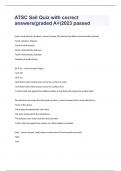
-
ATSC Sail Question and answers 2024 verified to pass
- Exam (elaborations) • 26 pages • 2024
- Available in package deal
-
- $14.99
- + learn more
ATSC Sail Question and answers 2024 verified to pass Fetch, wind velocity, duration - correct answer The factors that affect wave formation include: Fetch, duration, distance Fetch & wind velocity Fetch, wind velocity, distance Fetch, wind velocity, duration Duration & wind velocity (b) & (c) - correct answer Drag is: (a) & (b) (b) & (c) (b) Friction when wind moves across the surface of water (a) Friction when wind moves across the surface of air (c) Force that act...
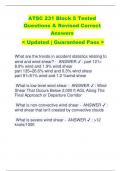
-
ATSC 231 Block 5 Tested Questions & Revised Correct Answers < Updated | Guaranteed Pass >
- Exam (elaborations) • 14 pages • 2024
-
- $16.34
- + learn more
ATSC 231 Block 5 Tested Questions & Revised Correct Answers < Updated | Guaranteed Pass > What are the trends in accident statistics relating to wind and wind shear? - ANSWER : part 121= 8.9% wind and 1.9% wind shear part 135=26.6% wind and 0.3% wind shear part 91=51% wind and 1.2 %wind shear What is low level wind shear - ANSWER : Wind Shear That Occurs Below 2,000 ft AGL Along The Final Approach or Departure Corridor What is non-convective wind shear - ANSWER : wind...
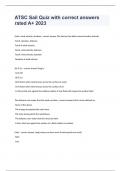
-
ATSC Sail Question and answers correctly solved 2024
- Exam (elaborations) • 26 pages • 2024
- Available in package deal
-
- $14.49
- + learn more
ATSC Sail Question and answers correctly solved 2024 Fetch, wind velocity, duration - correct answer The factors that affect wave formation include: Fetch, duration, distance Fetch & wind velocity Fetch, wind velocity, distance Fetch, wind velocity, duration Duration & wind velocity (b) & (c) - correct answer Drag is: (a) & (b) (b) & (c) (b) Friction when wind moves across the surface of water (a) Friction when wind moves across the surface of air (c) Force that act...
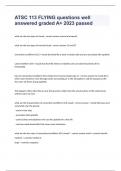
-
ATSC 113 FLYING questions with complete solution 2024
- Exam (elaborations) • 47 pages • 2024
- Available in package deal
-
- $13.49
- + learn more
ATSC 113 FLYING questions with complete solution 2024 what are the two types of clouds - correct answer normal and special what are the two types of normal clouds - correct answer CU and ST convective/cumiliform (CU) = clouds that look like a stack of cotton balls and are associated with updrafts Layer/stratiform (ST) = clouds that look like sheets or blankets and can extend hundreds of km horizontally how do convective/cumiliform (CU) clouds form (normal clouds type 1) - correct...
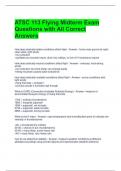
-
ATSC 113 Flying Midterm Exam Questions with All Correct Answers
- Exam (elaborations) • 20 pages • 2024
- Available in package deal
-
- $12.49
- + learn more
ATSC 113 Flying Midterm Exam Questions with All Correct Answers How does statically stable conditions affect flight - Answer- -forms near ground at night, clear skies, light winds -non-turbulent -oscillates as mountain-wave, drain into valleys, or form K-H turbulence waves How does statically neutral conditions affect flight - Answer- -overcast, mod-strong winds -non-turbulent, but wind shear can change easily -hitting mountain causes wake turbulence How does statically unstable c...
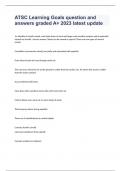
-
ATSC Learning Goals questions with complete solution 2024
- Exam (elaborations) • 28 pages • 2024
- Available in package deal
-
- $13.99
- + learn more
ATSC Learning Goals questions with complete solution 2024 1a. Identify & classify clouds, and relate them to local and larger-scale weather systems and to potential hazards to aircraft - correct answer Clouds can be normal or special. There are two types of normal clouds. Cumuliform (connective clouds) are puffy and associated with updrafts Form when humid air rises through cooler air This can occur when the air at the ground is colder than the surface (ex. Air above the ocean is co...
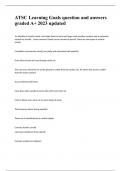
-
ATSC Learning Goals question and answers rated A+ 2024
- Exam (elaborations) • 28 pages • 2024
- Available in package deal
-
- $14.49
- + learn more
ATSC Learning Goals question and answers rated A+ 2024 1a. Identify & classify clouds, and relate them to local and larger-scale weather systems and to potential hazards to aircraft - correct answer Clouds can be normal or special. There are two types of normal clouds. Cumuliform (connective clouds) are puffy and associated with updrafts Form when humid air rises through cooler air This can occur when the air at the ground is colder than the surface (ex. Air above the ocean is colde...
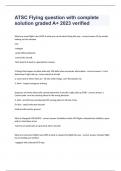
-
ATSC Flying question and answers 100% correct 2024
- Exam (elaborations) • 23 pages • 2024
- Available in package deal
-
- $14.49
- + learn more
ATSC Flying question and answers 100% correct 2024 What are visual flight rules (VFR) & what you can do when flying this way - correct answer Fly by mostly looking out the window Can: -navigate -avoid hitting obstacles -control the aircraft -find airports & land on appropirate runways 3 things that happen to pilots with only VFR skills when encounter obscuration - correct answer 1. Can't determine if right side up - loses control of aircraft 2. Lose track of where they are - fly ...
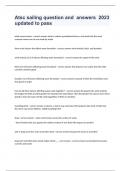
-
Atsc sailing question and answers 2024 verified to pass
- Exam (elaborations) • 38 pages • 2024
- Available in package deal
-
- $13.99
- + learn more
Atsc sailing question and answers 2024 verified to passwhat causes waves - correct answer water's motion, gravitational forces, and winds but the most common waves we see are made by winds three main factors that affect wave formation - correct answer wind velocity, fetch, and duration wind velocity (1/3 of factors affecting wave formation) - correct answer the speed of the wind fetch (2/3 of factors affecting wave formation) - correct answer the distance over water that the widn can ...

-
ATSC 113 final exam question and answers 2024 verified to pass
- Exam (elaborations) • 136 pages • 2024
- Available in package deal
-
- $15.49
- + learn more
ATSC 113 final exam question and answers 2024 verified to passFLYING SECTION: normal clouds - correct answer - classified into two categories 1. convective clouds/ cumuliform clouds (Cu) - look like stacks of cotton balls -- are associated with updrafts 2. layer clouds/ stratiform clouds (St) - look like sheets or blankets that can extend hundreds of kilometers horizontally. cumuliform clouds - correct answer cumuliform continued - correct answer - form when warm humid air rise...

Do you wonder why so many students wear nice clothes, have money to spare and enjoy tons of free time? Well, they sell on Stuvia! Imagine your study notes being downloaded a dozen times for $15 each. Every. Single. Day. Discover all about earning on Stuvia


